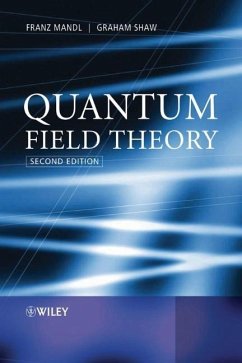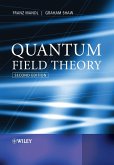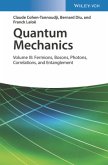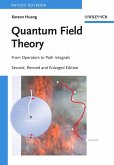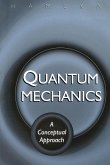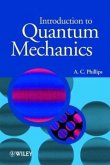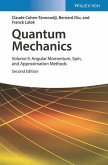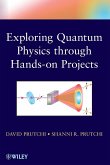- Gebundenes Buch
- Merkliste
- Auf die Merkliste
- Bewerten Bewerten
- Teilen
- Produkt teilen
- Produkterinnerung
- Produkterinnerung
Ein Klassiker, aktualisiert und modernisiert. Sorgfältig strukturiert - mathematische Herleitungen werden bei den Grundlagen beginnend eingeführt. Mit vielen Anwendungen und neuen Informationen zu Funktionen, Pfadintegralen und Eichfeldern sowie zur Renormierungsgruppe. Die Kapitel zur elektroschwachen Wechselwirkung wurden überarbeitet und erweitert. Enthalten sind jetzt auch Ausführungen zur elektroschwachen Wechselwirkung von Quarks und zu Majorana-Neutrinos.
Andere Kunden interessierten sich auch für
![Quantum Field Theory Quantum Field Theory]() Franz MandlQuantum Field Theory60,99 €
Franz MandlQuantum Field Theory60,99 €![Quantum Mechanics Quantum Mechanics]() Claude Cohen-TannoudjiQuantum Mechanics106,99 €
Claude Cohen-TannoudjiQuantum Mechanics106,99 €![Quantum Field Theory 2e Quantum Field Theory 2e]() Kerson HuangQuantum Field Theory 2e123,99 €
Kerson HuangQuantum Field Theory 2e123,99 €![Quantum Mechanics Quantum Mechanics]() Hendrik F. HamekaQuantum Mechanics123,99 €
Hendrik F. HamekaQuantum Mechanics123,99 €![Introduction to Quantum Mechanics Introduction to Quantum Mechanics]() A. C. PhillipsIntroduction to Quantum Mechanics68,99 €
A. C. PhillipsIntroduction to Quantum Mechanics68,99 €![Quantum Mechanics 2 Quantum Mechanics 2]() Claude Cohen-TannoudjiQuantum Mechanics 2101,99 €
Claude Cohen-TannoudjiQuantum Mechanics 2101,99 €![Exploring Quantum Physics Through Hands-On Projects Exploring Quantum Physics Through Hands-On Projects]() David PrutchiExploring Quantum Physics Through Hands-On Projects91,99 €
David PrutchiExploring Quantum Physics Through Hands-On Projects91,99 €-
-
-
Ein Klassiker, aktualisiert und modernisiert.
Sorgfältig strukturiert - mathematische Herleitungen werden bei den Grundlagen beginnend eingeführt. Mit vielen Anwendungen und neuen Informationen zu Funktionen, Pfadintegralen und Eichfeldern sowie zur Renormierungsgruppe. Die Kapitel zur elektroschwachen Wechselwirkung wurden überarbeitet und erweitert. Enthalten sind jetzt auch Ausführungen zur elektroschwachen Wechselwirkung von Quarks und zu Majorana-Neutrinos.
Hinweis: Dieser Artikel kann nur an eine deutsche Lieferadresse ausgeliefert werden.
Sorgfältig strukturiert - mathematische Herleitungen werden bei den Grundlagen beginnend eingeführt. Mit vielen Anwendungen und neuen Informationen zu Funktionen, Pfadintegralen und Eichfeldern sowie zur Renormierungsgruppe. Die Kapitel zur elektroschwachen Wechselwirkung wurden überarbeitet und erweitert. Enthalten sind jetzt auch Ausführungen zur elektroschwachen Wechselwirkung von Quarks und zu Majorana-Neutrinos.
Hinweis: Dieser Artikel kann nur an eine deutsche Lieferadresse ausgeliefert werden.
Produktdetails
- Produktdetails
- Verlag: Wiley & Sons
- 2. Aufl.
- Seitenzahl: 496
- Erscheinungstermin: 9. April 2010
- Englisch
- Abmessung: 254mm x 178mm x 33mm
- Gewicht: 960g
- ISBN-13: 9780471496830
- ISBN-10: 0471496839
- Artikelnr.: 13801235
- Herstellerkennzeichnung
- Libri GmbH
- Europaallee 1
- 36244 Bad Hersfeld
- gpsr@libri.de
- Verlag: Wiley & Sons
- 2. Aufl.
- Seitenzahl: 496
- Erscheinungstermin: 9. April 2010
- Englisch
- Abmessung: 254mm x 178mm x 33mm
- Gewicht: 960g
- ISBN-13: 9780471496830
- ISBN-10: 0471496839
- Artikelnr.: 13801235
- Herstellerkennzeichnung
- Libri GmbH
- Europaallee 1
- 36244 Bad Hersfeld
- gpsr@libri.de
Franz Mandl is the author of Quantum Field Theory, 2nd Edition, published by Wiley. Graham Shaw is the author of Quantum Field Theory, 2nd Edition, published by Wiley.
Preface xi
Notes xiii
1 Photons and the Electromagnetic Field 1
1.1 Particles and Fields 1
1.2 The Electromagnetic Field in the Absence of Charges 2
1.2.1 The classical field 2
1.2.2 Harmonic oscillator 5
1.2.3 The quantized radiation field 7
1.3 The Electric Dipole Interaction 9
1.4 The Electromagnetic Field in the Presence of Charges 14
1.4.1 Classical electrodynamics 14
1.4.2 Quantum electrodynamics 16
1.4.3 Radiative transitions in atoms 17
1.4.4 Thomson scattering 18
1.5 Appendix: The Schrödinger, Heisenberg and Interaction Pictures 20
Problems 22
2 Lagrangian Field Theory 25
2.1 Relativistic Notation 26
2.2 Classical Lagrangian Field Theory 27
2.3 Quantized Lagrangian Field Theory 30
2.4 Symmetries and Conservation Laws 31
Problems 37
3 The Klein-Gordon Field 39
3.1 The Real Klein-Gordon Field 39
3.2 The Complex Klein-Gordon Field 43
3.3 Covariant Commutation Relations 46
3.4 The Meson Propagator 48
Problems 53
4 The Dirac Field 55
4.1 The Number Representation for Fermions 55
4.2 The Dirac Equation 57
4.3 Second Quantization 61
4.3.1 The spin-statistics theorem 65
4.4 The Fermion Propagator 66
4.5 The Electromagnetic Interaction and Gauge Invariance 70
Problems 71
5 Photons: Covariant Theory 73
5.1 The Classical Fields 73
5.2 Covariant Quantization 77
5.3 The Photon Propagator 81
Problems 84
6 The S-Matrix Expansion 87
6.1 Natural Dimensions and Units 88
6.2 The S-Matrix Expansion 90
6.3 Wick's Theorem 94
7 Feynman Diagrams and Rules in QED 99
7.1 Feynman Diagrams in Configuration Space 100
7.2 Feynman Diagrams in Momentum Space 110
7.2.1 The first-order terms S(1) 112
7.2.2 Compton scattering 113
7.2.3 Electron-electron scattering 116
7.2.4 Closed loops 117
7.3 Feynman Rules for QED 118
7.4 Leptons 121
Problems 124
8 QED Processes in Lowest Order 127
8.1 The Cross-Section 128
8.2 Spin Sums 131
8.3 Photon Polarization Sums 133
8.4 Lepton Pair Production in (e+ e-) Collisions 135
8.5 Bhabha Scattering 139
8.6 Compton Scattering 142
8.7 Scattering by an External Field 147
8.8 Bremsstrahlung 153
8.9 The Infrared Divergence 155
Problems 158
9 Radiative Corrections 161
9.1 The Second-Order Radiative Corrections of QED 162
9.2 The Photon Self-Energy 167
9.3 The Electron Self-Energy 172
9.4 External Line Renormalization 176
9.5 The Vertex Modification 178
9.6 Applications 183
9.6.1 The anomalous magnetic moments 183
9.6.2 The Lamb shift 187
9.7 The Infrared Divergence 191
9.8 Higher-Order Radiative Corrections 193
9.9 Renormalizability 198
Problems 200
10 Regularization 203
10.1 Mathematical Preliminaries 204
10.1.1 Some standard integrals 204
10.1.2 Feynman parameterization 205
10.2 Cut-Off Regularization: The Electron Mass Shift 206
10.3 Dimensional Regularization 208
10.3.1 Introduction 208
10.3.2 General results 210
10.4 Vacuum Polarization 211
10.5 The Anomalous Magnetic Moment 214
Problems 217
11 Gauge Theories 219
11.1 The Simplest Gauge Theory: QED 220
11.2 Quantum Chromodynamics 222
11.2.1 Colour and confinement 222
11.2.2 Global phase invariance and colour conservation 225
11.2.3 SU(3) gauge invariance 227
11.2.4 Quantum chromodynamics 229
11.3 Alternative Interactions? 230
11.3.1 Non-minimal interactions 230
11.3.2 Renormalizability 233
11.4 Appendix: Two Gauge Transformation Results 235
11.4.1 The transformation law (11.26b) 236
11.4.2 The SU(3) gauge invariance of Eq. (11.34) 237
Problems 238
12 Field Theory Methods 241
12.1 Green Functions 241
12.2 Feynman Diagrams and Feynman Rules 246
12.2.1 The perturbation expansion 246
12.2.2 The vacuum amplitude 248
12.2.3 The photon propagator 249
12.2.4 Connected Green functions 252
12.3 Relation to S-Matrix Elements 254
12.3.1 Crossing 255
12.4 Functionals and Grassmann Fields 256
12.4.1 Functionals 257
12.4.2 Grassmann algebras and Grassmann fields 259
12.5 The Generating Functional 263
12.5.1 The free-field case 267
12.5.2 The perturbation expansion 270
Problems 272
13 Path Integrals 275
13.1 Functional Integration 275
13.1.1 Classical fields 276
13.1.2 Grassmann generators 281
13.1.3 Grassmann fields 283
13.2 Path Integrals 285
13.2.1 The generating functional 286
13.2.2 Free and interacting fields 287
13.2.3 The free electromagnetic field 289
13.2.4 The free spinor fields 291
13.3 Perturbation Theory 292
13.3.1 Wick's theorem 292
13.3.2 Interactions 294
13.4 Gauge Independent Quantization? 297
Problems 298
14 Quantum Chromodynamics 299
14.1 Gluon Fields 299
14.1.1 The generating functional 300
14.1.2 A mathematical analogy 301
14.1.3 The Faddeev-Popov Method 303
14.1.4 Gauge fixing and ghosts 304
14.1.5 The electromagnetic field revisited 306
14.2 Including Quarks 307
14.2.1 The QCD Lagrangian 307
14.2.2 The generating functional 309
14.2.3 Free fields 310
14.3 Perturbation Theory 312
14.3.1 Wick's theorem and propagators 312
14.3.2 The perturbation expansion 313
14.3.3 The vertex factors 313
14.4 Feynman Rules for QCD 318
14.5 Renormalizability of QCD 321
Problems 323
15 Asymptotic Freedom 325
15.1 Electron-Positron Annihilation 325
15.1.1 Two-jet events 326
15.1.2 Three-jet events 328
15.2 The Renormalization Scheme 330
15.2.1 The electron propagator 331
15.2.2 The photon propagator 333
15.2.3 Charge renormalization 335
15.3 The Renormalization Group 336
15.3.1 The renormalization group equations 337
15.3.2 Scale transformations 339
15.3.3 The running charge 341
15.4 The Strong Coupling Constant 343
15.4.1 Colour factors 344
15.4.2 Null diagrams 345
15.4.3 Renormalization of the coupling constant 346
15.4.4 The running coupling 351
15.5 Applications 352
15.6 Appendix: Some Loop Diagrams in QCD 357
15.6.1 The gluon self-energy graphs 357
15.6.2 The quark-gluon vertex corrections 360
Problems 362
16 Weak Interactions 363
16.1 Introduction 363
16.2 Leptonic Weak Interactions 365
16.3 The Free Vector Boson Field 369
16.4 The Feynman Rules for the IVB Theory 371
16.5 Decay Rates 372
16.6 Applications of the IVB Theory 373
16.6.1 Muon decay 373
16.6.2 Neutrino scattering 379
16.6.3 The leptonic decay of the W boson 380
16.7 Neutrino Masses 381
16.7.1 Neutrino oscillations 381
16.7.2 Dirac or Majorana neutrinos? 383
16.8 Difficulties with the IVB Theory 385
Problems 387
17 A Gauge Theory of Weak Interactions 389
17.1 QED Revisited 389
17.2 Global Phase Transformations and Conserved Weak Currents 391
17.3 The Gauge-Invariant Electroweak Interaction 395
17.4 Properties of the Gauge Bosons 399
17.5 Lepton and Gauge Boson Masses 401
18 Spontaneous Symmetry Breaking 403
18.1 The Goldstone Model 404
18.2 The Higgs Model 408
18.3 The Standard Electroweak Theory 412
19 The Standard Electroweak Theory 419
19.1 The Lagrangian Density in the Unitary Gauge 420
19.2 Feynman Rules 424
19.3 Elastic Neutrino-Electron Scattering 432
19.4 Electron-Positron Annihilation 435
19.5 The Higgs Boson 442
19.5.1 Higgs boson decays 444
19.5.2 Higgs boson searches 446
Problems 448
Appendix A The Dirac Equation 451
A.1 The Dirac Equation 451
A.2 Contraction Identities 453
A.3 Traces 453
A.4 Plane Wave Solutions 455
A.5 Energy Projection Operators 456
A.6 Helicity and Spin Projection Operators 456
A.7 Relativistic Properties 458
A.8 Particular Representations of the -Matrices 460
Problems 462
Appendix B Feynman Rules and Formulae for Perturbation Theory 463
Index 473
Notes xiii
1 Photons and the Electromagnetic Field 1
1.1 Particles and Fields 1
1.2 The Electromagnetic Field in the Absence of Charges 2
1.2.1 The classical field 2
1.2.2 Harmonic oscillator 5
1.2.3 The quantized radiation field 7
1.3 The Electric Dipole Interaction 9
1.4 The Electromagnetic Field in the Presence of Charges 14
1.4.1 Classical electrodynamics 14
1.4.2 Quantum electrodynamics 16
1.4.3 Radiative transitions in atoms 17
1.4.4 Thomson scattering 18
1.5 Appendix: The Schrödinger, Heisenberg and Interaction Pictures 20
Problems 22
2 Lagrangian Field Theory 25
2.1 Relativistic Notation 26
2.2 Classical Lagrangian Field Theory 27
2.3 Quantized Lagrangian Field Theory 30
2.4 Symmetries and Conservation Laws 31
Problems 37
3 The Klein-Gordon Field 39
3.1 The Real Klein-Gordon Field 39
3.2 The Complex Klein-Gordon Field 43
3.3 Covariant Commutation Relations 46
3.4 The Meson Propagator 48
Problems 53
4 The Dirac Field 55
4.1 The Number Representation for Fermions 55
4.2 The Dirac Equation 57
4.3 Second Quantization 61
4.3.1 The spin-statistics theorem 65
4.4 The Fermion Propagator 66
4.5 The Electromagnetic Interaction and Gauge Invariance 70
Problems 71
5 Photons: Covariant Theory 73
5.1 The Classical Fields 73
5.2 Covariant Quantization 77
5.3 The Photon Propagator 81
Problems 84
6 The S-Matrix Expansion 87
6.1 Natural Dimensions and Units 88
6.2 The S-Matrix Expansion 90
6.3 Wick's Theorem 94
7 Feynman Diagrams and Rules in QED 99
7.1 Feynman Diagrams in Configuration Space 100
7.2 Feynman Diagrams in Momentum Space 110
7.2.1 The first-order terms S(1) 112
7.2.2 Compton scattering 113
7.2.3 Electron-electron scattering 116
7.2.4 Closed loops 117
7.3 Feynman Rules for QED 118
7.4 Leptons 121
Problems 124
8 QED Processes in Lowest Order 127
8.1 The Cross-Section 128
8.2 Spin Sums 131
8.3 Photon Polarization Sums 133
8.4 Lepton Pair Production in (e+ e-) Collisions 135
8.5 Bhabha Scattering 139
8.6 Compton Scattering 142
8.7 Scattering by an External Field 147
8.8 Bremsstrahlung 153
8.9 The Infrared Divergence 155
Problems 158
9 Radiative Corrections 161
9.1 The Second-Order Radiative Corrections of QED 162
9.2 The Photon Self-Energy 167
9.3 The Electron Self-Energy 172
9.4 External Line Renormalization 176
9.5 The Vertex Modification 178
9.6 Applications 183
9.6.1 The anomalous magnetic moments 183
9.6.2 The Lamb shift 187
9.7 The Infrared Divergence 191
9.8 Higher-Order Radiative Corrections 193
9.9 Renormalizability 198
Problems 200
10 Regularization 203
10.1 Mathematical Preliminaries 204
10.1.1 Some standard integrals 204
10.1.2 Feynman parameterization 205
10.2 Cut-Off Regularization: The Electron Mass Shift 206
10.3 Dimensional Regularization 208
10.3.1 Introduction 208
10.3.2 General results 210
10.4 Vacuum Polarization 211
10.5 The Anomalous Magnetic Moment 214
Problems 217
11 Gauge Theories 219
11.1 The Simplest Gauge Theory: QED 220
11.2 Quantum Chromodynamics 222
11.2.1 Colour and confinement 222
11.2.2 Global phase invariance and colour conservation 225
11.2.3 SU(3) gauge invariance 227
11.2.4 Quantum chromodynamics 229
11.3 Alternative Interactions? 230
11.3.1 Non-minimal interactions 230
11.3.2 Renormalizability 233
11.4 Appendix: Two Gauge Transformation Results 235
11.4.1 The transformation law (11.26b) 236
11.4.2 The SU(3) gauge invariance of Eq. (11.34) 237
Problems 238
12 Field Theory Methods 241
12.1 Green Functions 241
12.2 Feynman Diagrams and Feynman Rules 246
12.2.1 The perturbation expansion 246
12.2.2 The vacuum amplitude 248
12.2.3 The photon propagator 249
12.2.4 Connected Green functions 252
12.3 Relation to S-Matrix Elements 254
12.3.1 Crossing 255
12.4 Functionals and Grassmann Fields 256
12.4.1 Functionals 257
12.4.2 Grassmann algebras and Grassmann fields 259
12.5 The Generating Functional 263
12.5.1 The free-field case 267
12.5.2 The perturbation expansion 270
Problems 272
13 Path Integrals 275
13.1 Functional Integration 275
13.1.1 Classical fields 276
13.1.2 Grassmann generators 281
13.1.3 Grassmann fields 283
13.2 Path Integrals 285
13.2.1 The generating functional 286
13.2.2 Free and interacting fields 287
13.2.3 The free electromagnetic field 289
13.2.4 The free spinor fields 291
13.3 Perturbation Theory 292
13.3.1 Wick's theorem 292
13.3.2 Interactions 294
13.4 Gauge Independent Quantization? 297
Problems 298
14 Quantum Chromodynamics 299
14.1 Gluon Fields 299
14.1.1 The generating functional 300
14.1.2 A mathematical analogy 301
14.1.3 The Faddeev-Popov Method 303
14.1.4 Gauge fixing and ghosts 304
14.1.5 The electromagnetic field revisited 306
14.2 Including Quarks 307
14.2.1 The QCD Lagrangian 307
14.2.2 The generating functional 309
14.2.3 Free fields 310
14.3 Perturbation Theory 312
14.3.1 Wick's theorem and propagators 312
14.3.2 The perturbation expansion 313
14.3.3 The vertex factors 313
14.4 Feynman Rules for QCD 318
14.5 Renormalizability of QCD 321
Problems 323
15 Asymptotic Freedom 325
15.1 Electron-Positron Annihilation 325
15.1.1 Two-jet events 326
15.1.2 Three-jet events 328
15.2 The Renormalization Scheme 330
15.2.1 The electron propagator 331
15.2.2 The photon propagator 333
15.2.3 Charge renormalization 335
15.3 The Renormalization Group 336
15.3.1 The renormalization group equations 337
15.3.2 Scale transformations 339
15.3.3 The running charge 341
15.4 The Strong Coupling Constant 343
15.4.1 Colour factors 344
15.4.2 Null diagrams 345
15.4.3 Renormalization of the coupling constant 346
15.4.4 The running coupling 351
15.5 Applications 352
15.6 Appendix: Some Loop Diagrams in QCD 357
15.6.1 The gluon self-energy graphs 357
15.6.2 The quark-gluon vertex corrections 360
Problems 362
16 Weak Interactions 363
16.1 Introduction 363
16.2 Leptonic Weak Interactions 365
16.3 The Free Vector Boson Field 369
16.4 The Feynman Rules for the IVB Theory 371
16.5 Decay Rates 372
16.6 Applications of the IVB Theory 373
16.6.1 Muon decay 373
16.6.2 Neutrino scattering 379
16.6.3 The leptonic decay of the W boson 380
16.7 Neutrino Masses 381
16.7.1 Neutrino oscillations 381
16.7.2 Dirac or Majorana neutrinos? 383
16.8 Difficulties with the IVB Theory 385
Problems 387
17 A Gauge Theory of Weak Interactions 389
17.1 QED Revisited 389
17.2 Global Phase Transformations and Conserved Weak Currents 391
17.3 The Gauge-Invariant Electroweak Interaction 395
17.4 Properties of the Gauge Bosons 399
17.5 Lepton and Gauge Boson Masses 401
18 Spontaneous Symmetry Breaking 403
18.1 The Goldstone Model 404
18.2 The Higgs Model 408
18.3 The Standard Electroweak Theory 412
19 The Standard Electroweak Theory 419
19.1 The Lagrangian Density in the Unitary Gauge 420
19.2 Feynman Rules 424
19.3 Elastic Neutrino-Electron Scattering 432
19.4 Electron-Positron Annihilation 435
19.5 The Higgs Boson 442
19.5.1 Higgs boson decays 444
19.5.2 Higgs boson searches 446
Problems 448
Appendix A The Dirac Equation 451
A.1 The Dirac Equation 451
A.2 Contraction Identities 453
A.3 Traces 453
A.4 Plane Wave Solutions 455
A.5 Energy Projection Operators 456
A.6 Helicity and Spin Projection Operators 456
A.7 Relativistic Properties 458
A.8 Particular Representations of the -Matrices 460
Problems 462
Appendix B Feynman Rules and Formulae for Perturbation Theory 463
Index 473
Preface xi
Notes xiii
1 Photons and the Electromagnetic Field 1
1.1 Particles and Fields 1
1.2 The Electromagnetic Field in the Absence of Charges 2
1.2.1 The classical field 2
1.2.2 Harmonic oscillator 5
1.2.3 The quantized radiation field 7
1.3 The Electric Dipole Interaction 9
1.4 The Electromagnetic Field in the Presence of Charges 14
1.4.1 Classical electrodynamics 14
1.4.2 Quantum electrodynamics 16
1.4.3 Radiative transitions in atoms 17
1.4.4 Thomson scattering 18
1.5 Appendix: The Schrödinger, Heisenberg and Interaction Pictures 20
Problems 22
2 Lagrangian Field Theory 25
2.1 Relativistic Notation 26
2.2 Classical Lagrangian Field Theory 27
2.3 Quantized Lagrangian Field Theory 30
2.4 Symmetries and Conservation Laws 31
Problems 37
3 The Klein-Gordon Field 39
3.1 The Real Klein-Gordon Field 39
3.2 The Complex Klein-Gordon Field 43
3.3 Covariant Commutation Relations 46
3.4 The Meson Propagator 48
Problems 53
4 The Dirac Field 55
4.1 The Number Representation for Fermions 55
4.2 The Dirac Equation 57
4.3 Second Quantization 61
4.3.1 The spin-statistics theorem 65
4.4 The Fermion Propagator 66
4.5 The Electromagnetic Interaction and Gauge Invariance 70
Problems 71
5 Photons: Covariant Theory 73
5.1 The Classical Fields 73
5.2 Covariant Quantization 77
5.3 The Photon Propagator 81
Problems 84
6 The S-Matrix Expansion 87
6.1 Natural Dimensions and Units 88
6.2 The S-Matrix Expansion 90
6.3 Wick's Theorem 94
7 Feynman Diagrams and Rules in QED 99
7.1 Feynman Diagrams in Configuration Space 100
7.2 Feynman Diagrams in Momentum Space 110
7.2.1 The first-order terms S(1) 112
7.2.2 Compton scattering 113
7.2.3 Electron-electron scattering 116
7.2.4 Closed loops 117
7.3 Feynman Rules for QED 118
7.4 Leptons 121
Problems 124
8 QED Processes in Lowest Order 127
8.1 The Cross-Section 128
8.2 Spin Sums 131
8.3 Photon Polarization Sums 133
8.4 Lepton Pair Production in (e+ e-) Collisions 135
8.5 Bhabha Scattering 139
8.6 Compton Scattering 142
8.7 Scattering by an External Field 147
8.8 Bremsstrahlung 153
8.9 The Infrared Divergence 155
Problems 158
9 Radiative Corrections 161
9.1 The Second-Order Radiative Corrections of QED 162
9.2 The Photon Self-Energy 167
9.3 The Electron Self-Energy 172
9.4 External Line Renormalization 176
9.5 The Vertex Modification 178
9.6 Applications 183
9.6.1 The anomalous magnetic moments 183
9.6.2 The Lamb shift 187
9.7 The Infrared Divergence 191
9.8 Higher-Order Radiative Corrections 193
9.9 Renormalizability 198
Problems 200
10 Regularization 203
10.1 Mathematical Preliminaries 204
10.1.1 Some standard integrals 204
10.1.2 Feynman parameterization 205
10.2 Cut-Off Regularization: The Electron Mass Shift 206
10.3 Dimensional Regularization 208
10.3.1 Introduction 208
10.3.2 General results 210
10.4 Vacuum Polarization 211
10.5 The Anomalous Magnetic Moment 214
Problems 217
11 Gauge Theories 219
11.1 The Simplest Gauge Theory: QED 220
11.2 Quantum Chromodynamics 222
11.2.1 Colour and confinement 222
11.2.2 Global phase invariance and colour conservation 225
11.2.3 SU(3) gauge invariance 227
11.2.4 Quantum chromodynamics 229
11.3 Alternative Interactions? 230
11.3.1 Non-minimal interactions 230
11.3.2 Renormalizability 233
11.4 Appendix: Two Gauge Transformation Results 235
11.4.1 The transformation law (11.26b) 236
11.4.2 The SU(3) gauge invariance of Eq. (11.34) 237
Problems 238
12 Field Theory Methods 241
12.1 Green Functions 241
12.2 Feynman Diagrams and Feynman Rules 246
12.2.1 The perturbation expansion 246
12.2.2 The vacuum amplitude 248
12.2.3 The photon propagator 249
12.2.4 Connected Green functions 252
12.3 Relation to S-Matrix Elements 254
12.3.1 Crossing 255
12.4 Functionals and Grassmann Fields 256
12.4.1 Functionals 257
12.4.2 Grassmann algebras and Grassmann fields 259
12.5 The Generating Functional 263
12.5.1 The free-field case 267
12.5.2 The perturbation expansion 270
Problems 272
13 Path Integrals 275
13.1 Functional Integration 275
13.1.1 Classical fields 276
13.1.2 Grassmann generators 281
13.1.3 Grassmann fields 283
13.2 Path Integrals 285
13.2.1 The generating functional 286
13.2.2 Free and interacting fields 287
13.2.3 The free electromagnetic field 289
13.2.4 The free spinor fields 291
13.3 Perturbation Theory 292
13.3.1 Wick's theorem 292
13.3.2 Interactions 294
13.4 Gauge Independent Quantization? 297
Problems 298
14 Quantum Chromodynamics 299
14.1 Gluon Fields 299
14.1.1 The generating functional 300
14.1.2 A mathematical analogy 301
14.1.3 The Faddeev-Popov Method 303
14.1.4 Gauge fixing and ghosts 304
14.1.5 The electromagnetic field revisited 306
14.2 Including Quarks 307
14.2.1 The QCD Lagrangian 307
14.2.2 The generating functional 309
14.2.3 Free fields 310
14.3 Perturbation Theory 312
14.3.1 Wick's theorem and propagators 312
14.3.2 The perturbation expansion 313
14.3.3 The vertex factors 313
14.4 Feynman Rules for QCD 318
14.5 Renormalizability of QCD 321
Problems 323
15 Asymptotic Freedom 325
15.1 Electron-Positron Annihilation 325
15.1.1 Two-jet events 326
15.1.2 Three-jet events 328
15.2 The Renormalization Scheme 330
15.2.1 The electron propagator 331
15.2.2 The photon propagator 333
15.2.3 Charge renormalization 335
15.3 The Renormalization Group 336
15.3.1 The renormalization group equations 337
15.3.2 Scale transformations 339
15.3.3 The running charge 341
15.4 The Strong Coupling Constant 343
15.4.1 Colour factors 344
15.4.2 Null diagrams 345
15.4.3 Renormalization of the coupling constant 346
15.4.4 The running coupling 351
15.5 Applications 352
15.6 Appendix: Some Loop Diagrams in QCD 357
15.6.1 The gluon self-energy graphs 357
15.6.2 The quark-gluon vertex corrections 360
Problems 362
16 Weak Interactions 363
16.1 Introduction 363
16.2 Leptonic Weak Interactions 365
16.3 The Free Vector Boson Field 369
16.4 The Feynman Rules for the IVB Theory 371
16.5 Decay Rates 372
16.6 Applications of the IVB Theory 373
16.6.1 Muon decay 373
16.6.2 Neutrino scattering 379
16.6.3 The leptonic decay of the W boson 380
16.7 Neutrino Masses 381
16.7.1 Neutrino oscillations 381
16.7.2 Dirac or Majorana neutrinos? 383
16.8 Difficulties with the IVB Theory 385
Problems 387
17 A Gauge Theory of Weak Interactions 389
17.1 QED Revisited 389
17.2 Global Phase Transformations and Conserved Weak Currents 391
17.3 The Gauge-Invariant Electroweak Interaction 395
17.4 Properties of the Gauge Bosons 399
17.5 Lepton and Gauge Boson Masses 401
18 Spontaneous Symmetry Breaking 403
18.1 The Goldstone Model 404
18.2 The Higgs Model 408
18.3 The Standard Electroweak Theory 412
19 The Standard Electroweak Theory 419
19.1 The Lagrangian Density in the Unitary Gauge 420
19.2 Feynman Rules 424
19.3 Elastic Neutrino-Electron Scattering 432
19.4 Electron-Positron Annihilation 435
19.5 The Higgs Boson 442
19.5.1 Higgs boson decays 444
19.5.2 Higgs boson searches 446
Problems 448
Appendix A The Dirac Equation 451
A.1 The Dirac Equation 451
A.2 Contraction Identities 453
A.3 Traces 453
A.4 Plane Wave Solutions 455
A.5 Energy Projection Operators 456
A.6 Helicity and Spin Projection Operators 456
A.7 Relativistic Properties 458
A.8 Particular Representations of the -Matrices 460
Problems 462
Appendix B Feynman Rules and Formulae for Perturbation Theory 463
Index 473
Notes xiii
1 Photons and the Electromagnetic Field 1
1.1 Particles and Fields 1
1.2 The Electromagnetic Field in the Absence of Charges 2
1.2.1 The classical field 2
1.2.2 Harmonic oscillator 5
1.2.3 The quantized radiation field 7
1.3 The Electric Dipole Interaction 9
1.4 The Electromagnetic Field in the Presence of Charges 14
1.4.1 Classical electrodynamics 14
1.4.2 Quantum electrodynamics 16
1.4.3 Radiative transitions in atoms 17
1.4.4 Thomson scattering 18
1.5 Appendix: The Schrödinger, Heisenberg and Interaction Pictures 20
Problems 22
2 Lagrangian Field Theory 25
2.1 Relativistic Notation 26
2.2 Classical Lagrangian Field Theory 27
2.3 Quantized Lagrangian Field Theory 30
2.4 Symmetries and Conservation Laws 31
Problems 37
3 The Klein-Gordon Field 39
3.1 The Real Klein-Gordon Field 39
3.2 The Complex Klein-Gordon Field 43
3.3 Covariant Commutation Relations 46
3.4 The Meson Propagator 48
Problems 53
4 The Dirac Field 55
4.1 The Number Representation for Fermions 55
4.2 The Dirac Equation 57
4.3 Second Quantization 61
4.3.1 The spin-statistics theorem 65
4.4 The Fermion Propagator 66
4.5 The Electromagnetic Interaction and Gauge Invariance 70
Problems 71
5 Photons: Covariant Theory 73
5.1 The Classical Fields 73
5.2 Covariant Quantization 77
5.3 The Photon Propagator 81
Problems 84
6 The S-Matrix Expansion 87
6.1 Natural Dimensions and Units 88
6.2 The S-Matrix Expansion 90
6.3 Wick's Theorem 94
7 Feynman Diagrams and Rules in QED 99
7.1 Feynman Diagrams in Configuration Space 100
7.2 Feynman Diagrams in Momentum Space 110
7.2.1 The first-order terms S(1) 112
7.2.2 Compton scattering 113
7.2.3 Electron-electron scattering 116
7.2.4 Closed loops 117
7.3 Feynman Rules for QED 118
7.4 Leptons 121
Problems 124
8 QED Processes in Lowest Order 127
8.1 The Cross-Section 128
8.2 Spin Sums 131
8.3 Photon Polarization Sums 133
8.4 Lepton Pair Production in (e+ e-) Collisions 135
8.5 Bhabha Scattering 139
8.6 Compton Scattering 142
8.7 Scattering by an External Field 147
8.8 Bremsstrahlung 153
8.9 The Infrared Divergence 155
Problems 158
9 Radiative Corrections 161
9.1 The Second-Order Radiative Corrections of QED 162
9.2 The Photon Self-Energy 167
9.3 The Electron Self-Energy 172
9.4 External Line Renormalization 176
9.5 The Vertex Modification 178
9.6 Applications 183
9.6.1 The anomalous magnetic moments 183
9.6.2 The Lamb shift 187
9.7 The Infrared Divergence 191
9.8 Higher-Order Radiative Corrections 193
9.9 Renormalizability 198
Problems 200
10 Regularization 203
10.1 Mathematical Preliminaries 204
10.1.1 Some standard integrals 204
10.1.2 Feynman parameterization 205
10.2 Cut-Off Regularization: The Electron Mass Shift 206
10.3 Dimensional Regularization 208
10.3.1 Introduction 208
10.3.2 General results 210
10.4 Vacuum Polarization 211
10.5 The Anomalous Magnetic Moment 214
Problems 217
11 Gauge Theories 219
11.1 The Simplest Gauge Theory: QED 220
11.2 Quantum Chromodynamics 222
11.2.1 Colour and confinement 222
11.2.2 Global phase invariance and colour conservation 225
11.2.3 SU(3) gauge invariance 227
11.2.4 Quantum chromodynamics 229
11.3 Alternative Interactions? 230
11.3.1 Non-minimal interactions 230
11.3.2 Renormalizability 233
11.4 Appendix: Two Gauge Transformation Results 235
11.4.1 The transformation law (11.26b) 236
11.4.2 The SU(3) gauge invariance of Eq. (11.34) 237
Problems 238
12 Field Theory Methods 241
12.1 Green Functions 241
12.2 Feynman Diagrams and Feynman Rules 246
12.2.1 The perturbation expansion 246
12.2.2 The vacuum amplitude 248
12.2.3 The photon propagator 249
12.2.4 Connected Green functions 252
12.3 Relation to S-Matrix Elements 254
12.3.1 Crossing 255
12.4 Functionals and Grassmann Fields 256
12.4.1 Functionals 257
12.4.2 Grassmann algebras and Grassmann fields 259
12.5 The Generating Functional 263
12.5.1 The free-field case 267
12.5.2 The perturbation expansion 270
Problems 272
13 Path Integrals 275
13.1 Functional Integration 275
13.1.1 Classical fields 276
13.1.2 Grassmann generators 281
13.1.3 Grassmann fields 283
13.2 Path Integrals 285
13.2.1 The generating functional 286
13.2.2 Free and interacting fields 287
13.2.3 The free electromagnetic field 289
13.2.4 The free spinor fields 291
13.3 Perturbation Theory 292
13.3.1 Wick's theorem 292
13.3.2 Interactions 294
13.4 Gauge Independent Quantization? 297
Problems 298
14 Quantum Chromodynamics 299
14.1 Gluon Fields 299
14.1.1 The generating functional 300
14.1.2 A mathematical analogy 301
14.1.3 The Faddeev-Popov Method 303
14.1.4 Gauge fixing and ghosts 304
14.1.5 The electromagnetic field revisited 306
14.2 Including Quarks 307
14.2.1 The QCD Lagrangian 307
14.2.2 The generating functional 309
14.2.3 Free fields 310
14.3 Perturbation Theory 312
14.3.1 Wick's theorem and propagators 312
14.3.2 The perturbation expansion 313
14.3.3 The vertex factors 313
14.4 Feynman Rules for QCD 318
14.5 Renormalizability of QCD 321
Problems 323
15 Asymptotic Freedom 325
15.1 Electron-Positron Annihilation 325
15.1.1 Two-jet events 326
15.1.2 Three-jet events 328
15.2 The Renormalization Scheme 330
15.2.1 The electron propagator 331
15.2.2 The photon propagator 333
15.2.3 Charge renormalization 335
15.3 The Renormalization Group 336
15.3.1 The renormalization group equations 337
15.3.2 Scale transformations 339
15.3.3 The running charge 341
15.4 The Strong Coupling Constant 343
15.4.1 Colour factors 344
15.4.2 Null diagrams 345
15.4.3 Renormalization of the coupling constant 346
15.4.4 The running coupling 351
15.5 Applications 352
15.6 Appendix: Some Loop Diagrams in QCD 357
15.6.1 The gluon self-energy graphs 357
15.6.2 The quark-gluon vertex corrections 360
Problems 362
16 Weak Interactions 363
16.1 Introduction 363
16.2 Leptonic Weak Interactions 365
16.3 The Free Vector Boson Field 369
16.4 The Feynman Rules for the IVB Theory 371
16.5 Decay Rates 372
16.6 Applications of the IVB Theory 373
16.6.1 Muon decay 373
16.6.2 Neutrino scattering 379
16.6.3 The leptonic decay of the W boson 380
16.7 Neutrino Masses 381
16.7.1 Neutrino oscillations 381
16.7.2 Dirac or Majorana neutrinos? 383
16.8 Difficulties with the IVB Theory 385
Problems 387
17 A Gauge Theory of Weak Interactions 389
17.1 QED Revisited 389
17.2 Global Phase Transformations and Conserved Weak Currents 391
17.3 The Gauge-Invariant Electroweak Interaction 395
17.4 Properties of the Gauge Bosons 399
17.5 Lepton and Gauge Boson Masses 401
18 Spontaneous Symmetry Breaking 403
18.1 The Goldstone Model 404
18.2 The Higgs Model 408
18.3 The Standard Electroweak Theory 412
19 The Standard Electroweak Theory 419
19.1 The Lagrangian Density in the Unitary Gauge 420
19.2 Feynman Rules 424
19.3 Elastic Neutrino-Electron Scattering 432
19.4 Electron-Positron Annihilation 435
19.5 The Higgs Boson 442
19.5.1 Higgs boson decays 444
19.5.2 Higgs boson searches 446
Problems 448
Appendix A The Dirac Equation 451
A.1 The Dirac Equation 451
A.2 Contraction Identities 453
A.3 Traces 453
A.4 Plane Wave Solutions 455
A.5 Energy Projection Operators 456
A.6 Helicity and Spin Projection Operators 456
A.7 Relativistic Properties 458
A.8 Particular Representations of the -Matrices 460
Problems 462
Appendix B Feynman Rules and Formulae for Perturbation Theory 463
Index 473

